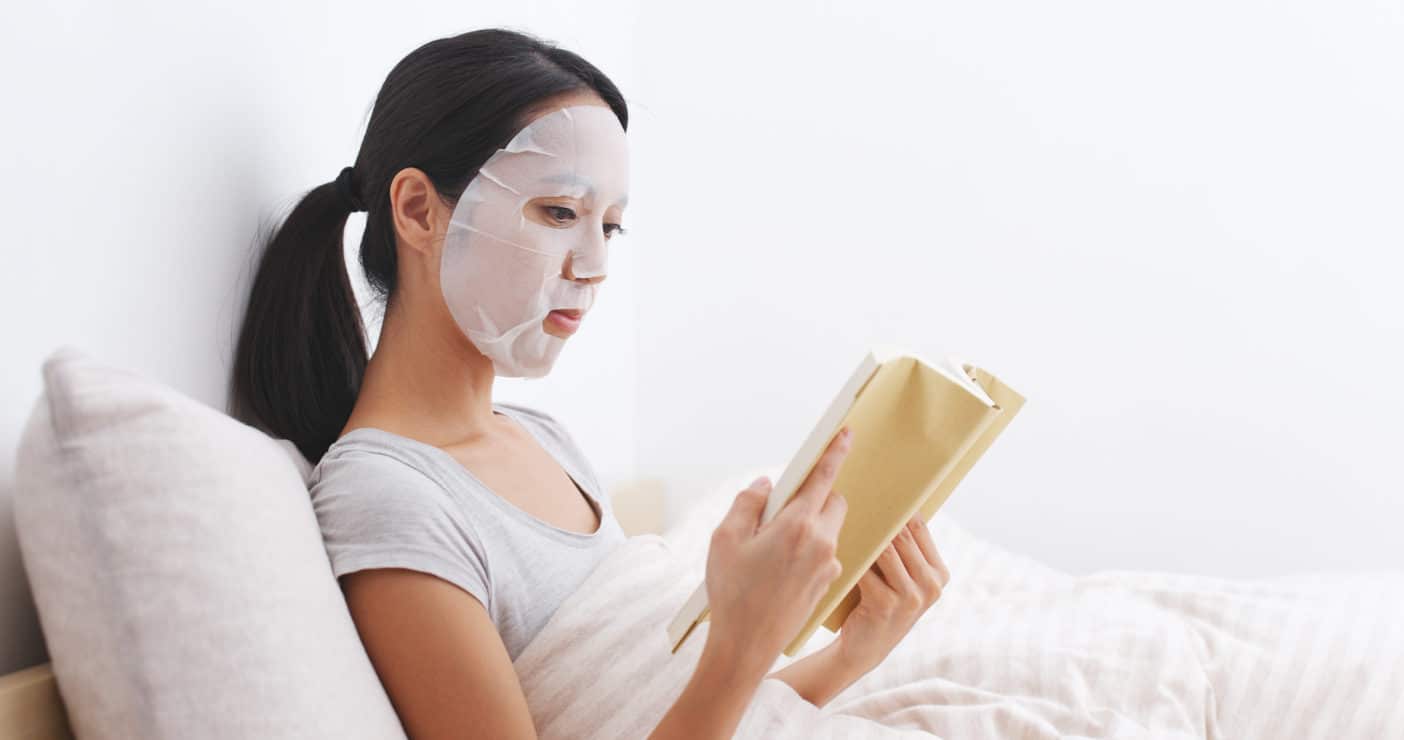moisture masks

Face masks and particularly moisture masks are basic products in almost all cosmetic cabinets. They restore the skin to equilibrium and are key in comprehensive skincare rituals. The ingredients of the beauty boosters penetrate deep into the upper skin layers and, dependent on their composition, have moisturizing, invigorating, cleansing, or calming effects. Corresponsingly, the range of choice is vast. However, doesn’t it matter what moisture mask you pick out? No! Consumers should always take into consideration their individual skin type. Anti-aging masks, e.g., are especially geared to mature skin while cleansing masks work to plump up by replenishing skin’s water depots to give skin a refreshed, vitalized, and more youthyful look immediately.
Which masks are popular?
Principally, face masks can be subdivided in three categories: cream masks, peel-off masks, and fleece masks. Most cream masks are rich moisture masks. They are applied to the face like day creams and removed gently with lukewarm water after a short time of working in.
Fleece masks, also called “sheet masks”, are fabrics saturated with a serum. The are easy and comfortable to apply and ideal on the go or for travelling. Sheet masks are made of different materials. At present, hydrogel is the upper class because it absolutely flexibly adapts to the facial contours, virtually like a second skin. The same applies to fleece masks made of biocellulose. They are mainly used in luxury cosmetic lines and release maximum quantities of active ingredients.
Peel-off masks feature a quickly drying gel layer. After application, the masks are simply peeled off from the face, smultaneouly lifting off skin flakes, blackheads, and dirt from the pores. They leave skin thoroughly cleansed deep down to the pores.
Despite their many advantages, moisture masks have fallen into disrepute recently. The criticism refers to the ordinary products, whereas moisture masks in the segment of natural cosmetics are not concerned.
Ökotest detected that many moisture masks contain soluble plastic material. The synhetic compounds mean a considerable danger to the environment as they severely pollute the waste water. Frequently, the synthetic polymers in the sludges are poured on our fields.
Also PEG compounds are not rare substance in moisture masks. Meanwhile it has become a known fact that they can infiltrate undesirable foreign substances into the skin. Many moisture masks contain chlorophenesin. The preservative is regarded as being skin-irritating. It is an organohalogen compound anyhow vehemently controversial. Silicones are used in moisture masks for a more pleasant skin feeling. They do not offer any skincare effect, however, exactly the opposite.
The institute also found out that even moisture masks of renonwned and prestigious brands contain parabens.
Perfumes in moisture masks could be another source of problems. For example, hydroxy citronellal frequently triggers allergies. Lilia, found in several moisture masks, is suspected of impairing reproductiveness.
The disadvantages of ordinary moisture masks go beyond the products: their packaging, too, is frequently a case of problem. Sealed in plastic films and elaborately designed, the sachets are eye-catching and encouraging to be bought while being composite materials frequently using aluminium as blocking layers and therefore not suitable for recycling.
How perfect moisture masks should be composed?
Clean Beauty moisture masks do not use PEG and PEG derivatives and are free of organohalogen compounds. Also butylphenyl methylpropional (better known as the perfume ingredient lilial) is not found in Clean Beauty moisture masks. The same applies to declarable perfume ingredients which could cause allergies such as hydroxycitronellal. Silicone compounds and paraffins or synthetic paraffin-like substances impair the quality of a product.
Aditionally, moisture masks should be free of synthetic polymers like Acrylates/C10-30 Alkyl Acrylate Crosspolymer, Glyceryl Acrylate/Acrylic Acid Copolymer, Hydroxyethyl Acrylate/Sodium Acryloyldimethyl Taurate Copolymer, Nylon-12, Polyvinyl Alcohol, Sodium Polyacrylate, Sodium Polyacrylate Starch, and PVM/MA Copolymer.
An environmentally friendly alternative to composite materials and aluminium is OPP monofilm. The material has been proven in food industry and is recycable. OPP monofilms are resistant to cracks and shockproof, all in all, very tearproof and stable.
Recommendable active agents for moisture masks
We now know which substances are undesirable in moisture masks.
But which substances are recommendable?
One example is sodium hyaluronate crosspolymer. It is a smaller form of hyaluronic acid with a 3D molecular structure storing moisture for a longer period and deeper in the skin than the higher-weight molecules of hyaluronc acid. The substance functions like a kind of sponge and used in moisture masks it leaves skin looking really plumper, smoother, and younger. Sodium hyaluronate has similarly positive properties. It is excellently absorbed by skin and enhances hydration.
Portrait Sodium hyaluronate crosspolymer
INCI: Sodium Hyaluronate Crosspolymer
CAS number: 162975-50-0
Effect: functions as a “moisture sponge”, maintains skin’s moisture balance
Portrait Sodium hyaluronate
INCI: Sodium Hyaluronate
CAS number: 9067-32-7
Effect: similar to sodium hyaluronate crosspolymer
Dead Sea mud is rich in precious minerals and oligoelements. Especially worth mentioning are magnesium, bromine, potassium, and calcium. They are particularly effective for problem skin. The high mineral content is very helpful for inflammatory skin diseases like acne or psoriasis. A Dead Sea mask fights bacteria that could cause pimples, cleanses the skin and removes excessive sebum. The complexion appears more even and beautiful, cleared of impurities. In addition, the sea salt removes thick horny skin and refines the pores.
A natural moisturizing factor of the skin ist sodium PCA (PCA is the abbreviation of pyrrolidone carboxylic acid). The subsance is rich in sodium salts and supports skin’s moisture production and suppleness. Ideal for superior moisture masks! The salt of the pyrrolidone carboxylic acid is such an advantageous ingredient because pyrrolidone carboxylic acid is a nearly 12 % component of skin’s own “Natural Moisturizing Factor” (NMF).
Portrait Sodium PCA
INCI: Sodium PCA
CAS number: 28874-51-3
Effect: hydrating
The zinc salt of L-pyrrolidone carboxylate is also known as zinc PCA. It a real multi-talent, ideal for moisture masks for combination skin as is combines moisturizing and sebum-regulating effects. It is also suitable for formulations for acne and caring products for dandruff and oily scalp.
Portrait Zinc PCA
INCI: Zinc PCA
CAS number: 15454-75-8
Effect: reduces sebum production, antimicrobial, moisturizing
Magnesium aspartate is an anorganic magnesium salt helping to minimize damaging influences on the skin. The substance activates skin’s energy metabolism, enhances the effectiveness of vitamins, and supports the removal of wastes from the skin.
Portrait Magnesium aspartate
INCI: Magnesium Aspartate
CAS number: 18962-61-3
Effect: protects against external factors, maintains skin’s health
Zinc glyconate, a salt of glyconic acid, reduces sebum production, supports skin’s detoxification process, refines large-pored skin, anti-inflammatory
Steckbrief Zinc gluconate
INCI: Zinc Gluconate
CAS number: 4468-02-4
Effect: antibacterial and astringent, protects against collagen decompostion induced by sun exposure
Copper gluconate is involved in keeping the connective tissue structures healthy and protects skin from external influences. It revitalizes the skin and has astringent properties.
Portrait Copper gluconate
INCI: Copper Gluconate
CAS number: 527-09-3
Effect: cares for skin and helps to maintain its good condition
Other active agents for beauty and moisture masks:
Fruit water like vitis vinifera (grape) from the fruits of the red grape (CAS number: 84929-27-1) or aloe vera direct juice.
Which mask for which target?
Teenager skin sometimes behaves unpredictably. We frequently recommend cleansing masks with peeling effect or masks with healing clay.
Moisture masks generally are good choices for those who want to maintain skin’s vitality and a glowing appearance. The application of a moisture mask once weekly will preserve skin’s youthfulness.
In its thirties, skin reveals the first visible signs of years of life. A cleansing mask at least once weekly is recommendable.
In the forties, most of us feel younger than they look. To keep feeling of life and appearane in harmony, a hydrogel mask with a high percentage of hyaluronic acid and a mix of peptides should be integrated into the weekly skincare regimen.
In later years, mature skin will profit by emulsion masks rich in unsaturated fatty acids (linoleic acid and linolenic acid). Especially beneficial are additives of linseed oil, almond oil, and pomegranate seed oil. Wheat germ oil, borage oil, or evening primrose oil also are excellent but combined with a slightly fatty smell.
Flece or sheet masks are ideal supplements for quick applications. They are made of different materials, some of them boosting effectivenss („second skin“) or particularly sustainable (100% biocellulose). These masks are rich in active agents giving skin a plump and rosy appearance wthin 15 minutes or even faster.
Clean Beauty moisture masks by Cosmacon
Moisture masks are a beneficial treat for the skin, provided that they are free of questionable ingredients. Cosmacon is ready to carry out the development of your superior Clean Beauty moisture masks, if desired, with sustainable and recyclable films.
Please contact us with your questions. We are eager to provide you with our professional advice!
